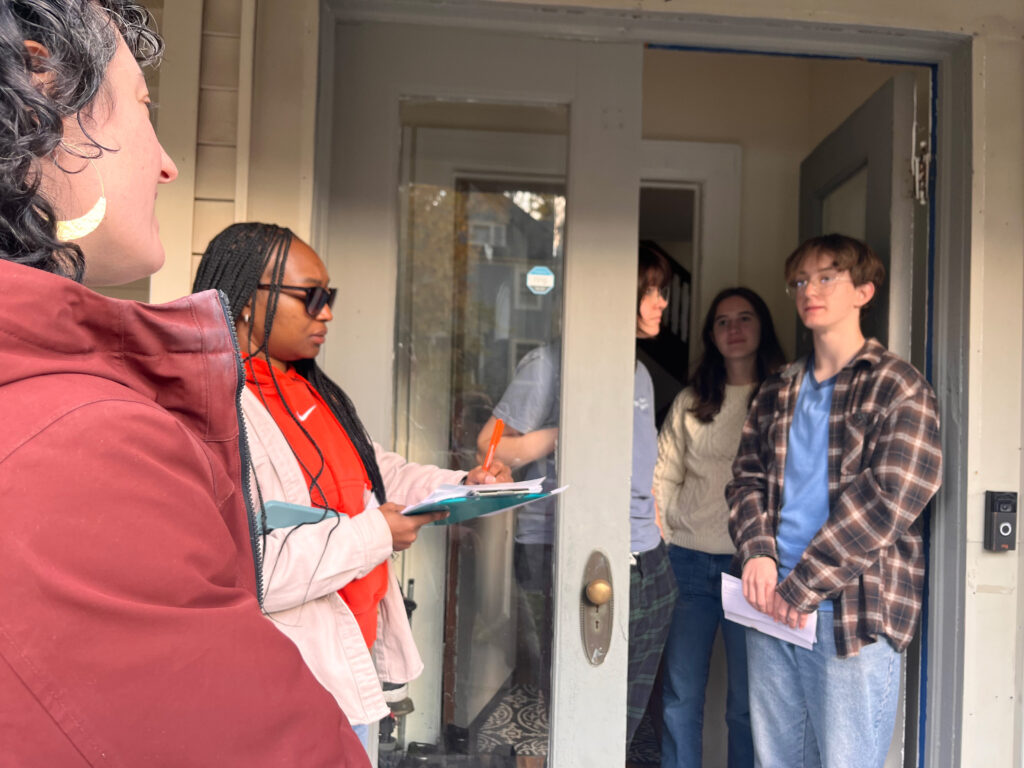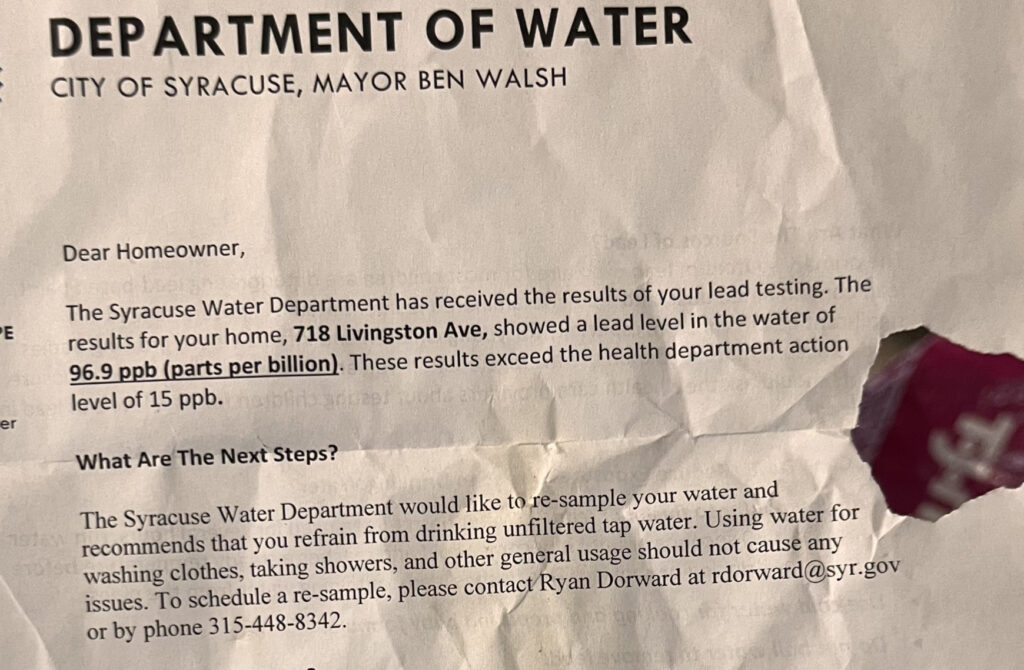
Video Transcript: Syracuse officials spread misinformation, downplayed lead water test results, NRDC said
This is my basement here. It’s really messy as a bunch of skis. A few months ago, Micky Wehrle couldn’t have told you much about his water line. This right here is the water line. This galvanized he and his roommates were completely unaware of the lead service line connecting their home to the city of Syracuse’s water system, that is, until they received a notice in the mail from the department of water in August stating that a recent sample of their water contained 96.9 parts per billion of lead, over six times the Environmental Protection Agency’s emergency action level of 15 parts per billion. So we’re like, Oh, that’s great. Like all of last year, we were drinking water with terrible amounts of lead in it. The EPA maintains there is no safe level of lead consumption for humans requiring the department of water to test for lead at the tap in homes, including those with lead service lines. If 10% of homes test higher than 15 parts per billion, the city is required to take action, providing education to impacted households and removing lead service lines. Results from this summer showed 26% of homes were above the action level. Worley’s home was one of them, shocking, surprising, frustrating, a little bit of anger in there too. These dangerously high results triggered a citywide retest, and while collection is still ongoing, tentative results published by the city showed a reduction in lead levels. Wehrle’s retest sample, which was self collected, showed a level of only 1.6 parts per billion, down from 96.9 in an interview with CNY central Mayor Ben Walsh, pushed back against comparisons to Flint, Michigan’s lead crisis. And water commissioner Robert Brandt suggested that higher lead levels could be attributed to stagnant water in lead service lines. That didn’t convince Valerie Baron, a senior attorney with the NRDC, who has experience with similar cases around the country. The city has repeatedly said that the test was an anomaly, but that’s irrelevant. Where the regulation is concerned, the regulation doesn’t say you get to ignore an anomaly. In fact, the regulation is designed to let the water sit in the pipes. The experience of some residents suggest major flaws in the city’s testing procedure. Several whose homes were among those flagged in the initial round of testing told NCC news they had no idea when or how the city had sampled their water. The first time, answers came last month when the city placed two water testing employees on administrative leave, alleging the employees improperly took samples from exterior faucets and hoses, among other violations. EPA regulation is clear that samples under the Safe Drinking Water Act measure for lead need to come from a kitchen or a bathroom faucet. Any sample that came from anywhere else would be a violation, and the city definitely has some explaining to do. Based on the home visits that we did, Wehrle says he and his roommates have done their best to reduce their exposure purchasing NSF certified filtered pitchers for their drinking water and letting the tap run for two minutes before use. Reporting in Syracuse. I’m Andrew hood. NCC news.
Syracuse, N.Y. (NCC NEWS)– A few months ago Micky Wehrle couldn’t have told you much about his water line. He and his roommates were completely unaware of the lead service line connecting their home to the City of Syracuse’s water system. That is, until they received a notice in the mail from the Department of Water in August stating that a recent sample of their water contained 96.9 parts per billion of lead — over six times the Environmental Protection Agency’s emergency action level of 15 ppb.
There is no safe level of lead consumption for humans, according to the EPA.
The EPA requires utilities like Syracuse’s Department of Water to test for lead at the tap in homes, including those with lead service lines. If 10% of the samples from these homes test higher than 15 ppb, the utility is required to take action: providing education to impacted households and removing lead service lines according to EPA regulation.
Over the summer, the Department of Water tested 104 homes throughout the city. Twenty-seven returned a result of over 15 ppb, nearly 26% of the sample.

Wehrle’s home, which he and his roommates have rented for over a year, was one of the 27 homes tested by the city this summer that registered levels over the EPA’s action level, according to city records obtained by the National Resource Defense Council, a water safety watchdog.
“(Our landlord) told us it’s the city’s responsibility, the city says it’s the landlord’s responsibility.” Wehrle said. “Someone has to take the step.”
These results triggered a retest. The city sent out notices to the impacted homes alongside a request to provide a self-collected water sample for retesting.
While the collection of retest data is still ongoing, the city released tentative results in mid-October showing a significant reduction in the number of homes above the action level. Wehrle’s retest sample (which was self-collected) showed only 1.6 ppb, according to a letter Wehrle received from the city.
City officials used National Lead Poisoning Prevention Week as an opportunity to frame the first round of testing as an anomaly. In an interview with LocalSyr, Mayor Ben Walsh pushed back against comparisons to the lead crisis in Flint, Michigan.
Water Commissioner Robert Brandt suggested that high lead levels could be attributed to stagnant water in lead service lines. He said more time in the pipe gives lead more time to leach into the water.
“It’s vacation season. We could have been testing water that had sat for long periods of time due to people not being home,” said Brandt in a separate interview with LocalSyr. “There’s a lot of factors that play into it.”
That response didn’t convince Valerie Baron, a senior attorney with the NRDC. Baron has experience with similar cases around the country, including in Newark, New Jersey, which suffered its own lead contamination crisis in 2016 and is now in the process of removing over 18,000 lead service lines at no direct cost to property owners according to the NRDC.
“(Syracuse) has repeatedly said that the test was an anomaly, but that’s irrelevant where the regulation is concerned,” said Baron “The regulation doesn’t say you get to ignore an anomaly. In fact, the regulation is designed to let the water sit in the pipes.”
The city’s own self-test instructions say residents must wait a minimum of six hours during which no water in the house can be used prior to taking a sample.
Baron, who is based in Washington D.C., spent Sunday canvassing Syracuse with a trunk full of NSF-certified water filters, speaking with residents whose homes were flagged in the initial round of testing.
The experience of some residents suggests serious inconsistencies in the city’s testing procedure.
Four households whose homes were among the 27 flagged by the initial round of testing this summer told NCC News they had no idea how or when the city sampled their water the first time. Some theorized that the samples came from exterior faucets at the side of their homes rather than an interior source like a kitchen tap. Baron said this practice could radically skew testing results.
“EPA regulation is clear that samples under the Safe Drinking Water Act to measure for lead need to come from a kitchen or a bathroom faucet,” Baron said. “Any sample that came from anywhere else would be a violation and wouldn’t count towards the samples that the city is required to take. The city definitely has some explaining to do based on the home visits that we did.”
The city maintains that its procedure is sound.
“The Department of Water closely monitors results to ensure the integrity of samples,” city spokesperson Sol Muñoz wrote in an email. “Additionally, both the County and State oversee the results to confirm that the City adheres to all appropriate testing procedures and regulations.”
Wehrle says he and his roommates have done their best to reduce their exposure, purchasing NSF-certified filtered pitchers for their drinking water and letting the tap run for two minutes before use.
